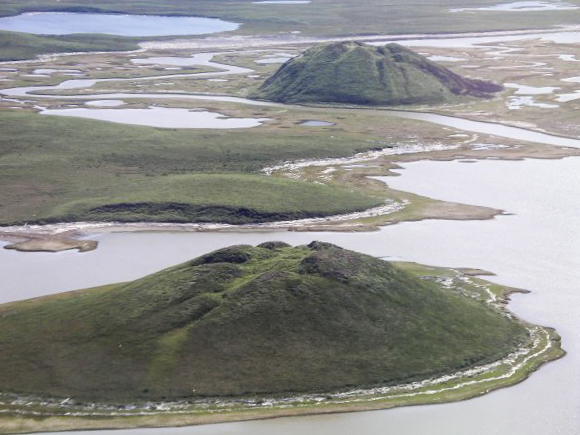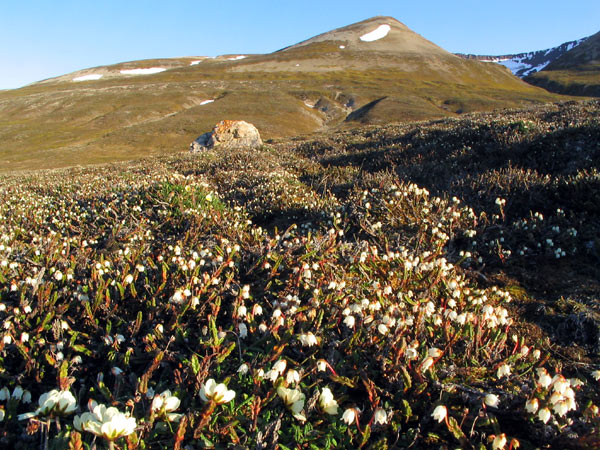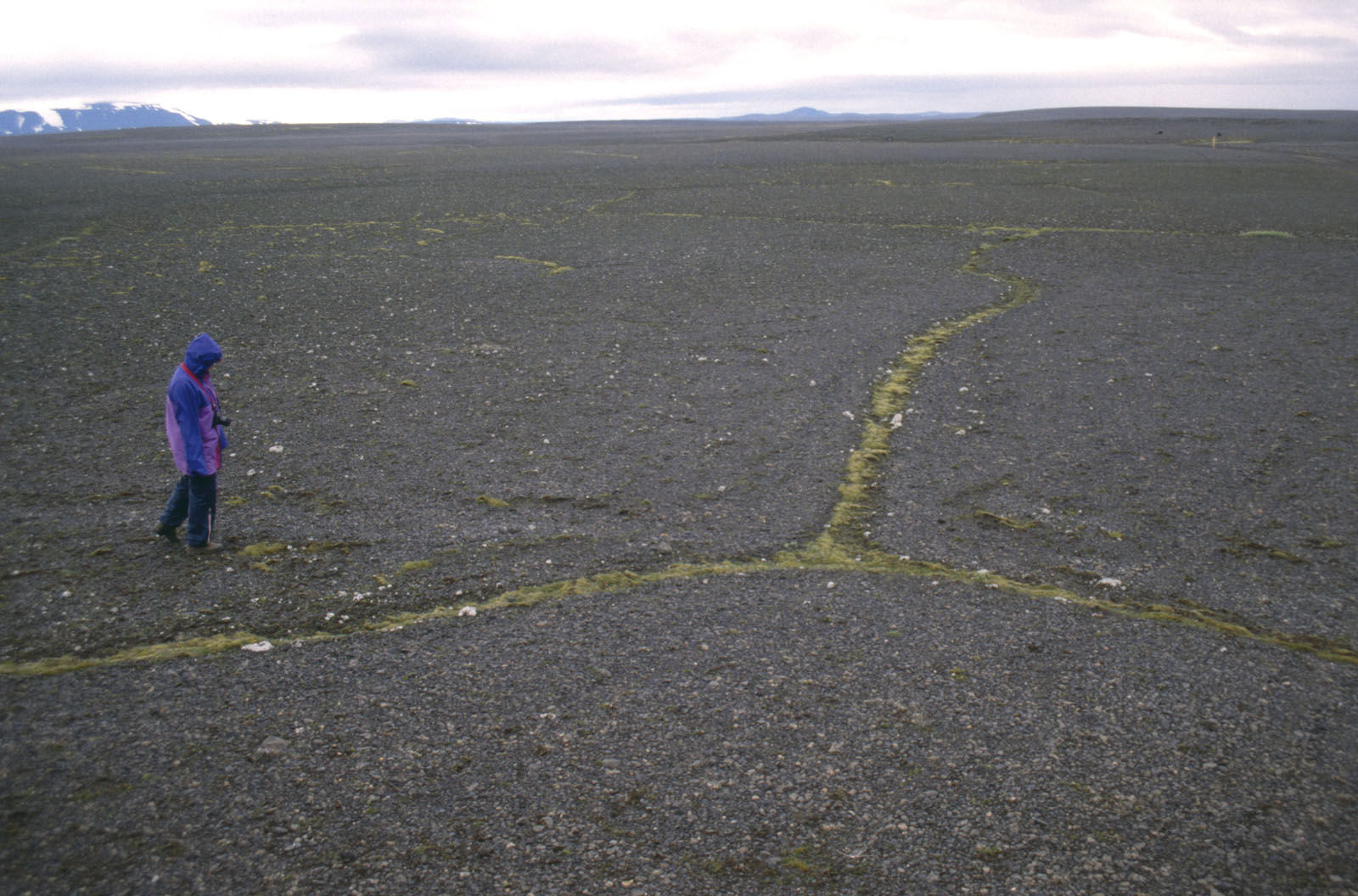|
Pingo Canadian Landmark
Pingo Canadian Landmark, also known as Pingo National Landmark, is a natural area protecting eight pingos near Tuktoyaktuk, Northwest Territories. It is in a coastal region of the Arctic Ocean which contains approximately 1,350 Arctic ice dome hills—approximately one quarter of the world's pingos. History The area has been a focus of scientific study for over 50 years, and research here has formed the basis of current understanding about the origin and growth of pingos. The region was first identified as a site of national significance in 1978, and landmark status was proposed. Legislation creating it in 1984 formed part of the Inuvialuit Final Agreement (officially, the Western Arctic (Inuvialuit) Claims Settlement Act (1984)). It provided for cooperative management of the Landmark between the Government of Canada, the Inuvialuit Land Administration, and the people of Tuktoyaktuk. It reserved subsurface rights for the Inuvialuit, federal jurisdiction for the surface, and ... [...More Info...] [...Related Items...] OR: [Wikipedia] [Google] [Baidu] |
Pingo
Pingos are intrapermafrost ice-cored hills, high and in diameter. They are typically conical in shape and grow and persist only in permafrost environments, such as the Arctic and subarctic. A pingo is a periglacial landform, which is defined as a non-glacial landform or process linked to colder climates. It is estimated that there are more than 11,000 pingos on Earth. The Tuktoyaktuk peninsula area has the greatest concentration of pingos in the world with a total of 1,350 pingos. There is currently remarkably limited data on pingos. History In 1825, John Franklin made the earliest description of a pingo when he climbed a small pingo on Ellice Island in the Mackenzie Delta. However, it was in 1938 that the term ''pingo'' was first borrowed from the Inuvialuit by the Arctic botanist Alf Erling Porsild in his paper on Earth mounds of the western Arctic coast of Canada and Alaska. Porsild Pingo in Tuktoyaktuk is named in his honour. The term pingos, which in Inuvialuktun m ... [...More Info...] [...Related Items...] OR: [Wikipedia] [Google] [Baidu] |
Hydrostatics
Fluid statics or hydrostatics is the branch of fluid mechanics that studies the condition of the equilibrium of a floating body and submerged body "fluids at hydrostatic equilibrium and the pressure in a fluid, or exerted by a fluid, on an immersed body". It encompasses the study of the conditions under which fluids are at rest in stable equilibrium as opposed to fluid dynamics, the study of fluids in motion. Hydrostatics is a subcategory of fluid statics, which is the study of all fluids, both compressible or incompressible, at rest. Hydrostatics is fundamental to hydraulics, the engineering of equipment for storing, transporting and using fluids. It is also relevant to geophysics and astrophysics (for example, in understanding plate tectonics and the anomalies of the Earth's gravitational field), to meteorology, to medicine (in the context of blood pressure), and many other fields. Hydrostatics offers physical explanations for many phenomena of everyday life, such as why ... [...More Info...] [...Related Items...] OR: [Wikipedia] [Google] [Baidu] |
Vaccinium Vitis-idaea
''Vaccinium vitis-idaea'', the lingonberry, partridgeberry, mountain cranberry or cowberry, is a small evergreen shrub in the heath family Ericaceae, that bears edible fruit. It is native to boreal forest and Arctic tundra throughout the Northern Hemisphere, from Europe and Asia to North America. Lingonberries are picked in the wild and used to accompany a variety of dishes in Northern Baltoscandia, Russia, Canada and Alaska. Commercial cultivation is undertaken in the U.S. Pacific Northwest and in many other regions of the world. Names ''Vaccinium vitis-idaea'' is most commonly known in English as 'lingonberry' or 'cowberry'.Gray's Manual of Botany: Asa GrayInteractive Flora of Northwest Europe''Vaccinium vitis-idaea''/ref> The name 'lingonberry' originates from the Swedish name for the species, and is derived from the Norse , or heather. The genus name ''Vaccinium'' is a classical Latin name for a plant, possibly the bilberry or hyacinth, and may be derived from the Latin , ... [...More Info...] [...Related Items...] OR: [Wikipedia] [Google] [Baidu] |
Berry
A berry is a small, pulpy, and often edible fruit. Typically, berries are juicy, rounded, brightly colored, sweet, sour or tart, and do not have a stone or pit, although many pips or seeds may be present. Common examples are strawberries, raspberries, blueberries, blackberries, red currants, white currants and blackcurrants. In Britain, soft fruit is a horticultural term for such fruits. In common usage, the term "berry" differs from the scientific or botanical definition of a fruit produced from the ovary of a single flower in which the outer layer of the ovary wall develops into an edible fleshy portion ( pericarp). The botanical definition includes many fruits that are not commonly known or referred to as berries, such as grapes, tomatoes, cucumbers, eggplants, bananas, and chili peppers. Fruits commonly considered berries but excluded by the botanical definition include strawberries, raspberries, and blackberries, which are aggregate fruits and mulberries, which ar ... [...More Info...] [...Related Items...] OR: [Wikipedia] [Google] [Baidu] |
Betula Glandulosa
''Betula glandulosa'', the American dwarf birch, also known as resin birch or shrub birch, is a species of birch native to North America. Description American dwarf birch is a multi-stemmed shrub typically growing to tall, often forming dense thickets. The trunks are slender, rarely over diameter, with smooth, dark brown bark. The leaves are nearly circular to oval, long and broad, with a toothed margin. The fruiting catkins are erect, long and broad. It is closely related to the dwarf birch (''Betula nana''), and is sometimes treated as a subspecies of it, as ''B. nana'' subsp. ''glandulosa''. It is distinguished from typical ''B. nana'' by the presence of glandular warts on the shoots and longer leaf petioles. Hybrids with several other birches occur. Distribution and habitat This plant occurs in arctic and cool temperate areas from Alaska east to Newfoundland and southern Greenland, and south at high altitudes to northern California, Colorado, and the Black Hills of ... [...More Info...] [...Related Items...] OR: [Wikipedia] [Google] [Baidu] |
Rhododendron Tomentosum
''Rhododendron tomentosum'' ( syn. ''Ledum palustre''), commonly known as marsh Labrador tea, northern Labrador tea or wild rosemary, is a flowering plant in the subsection '' Ledum'' of the large genus '' Rhododendron'' in the family Ericaceae. Description It is a low shrub growing to 50 cm (rarely up to 120 cm) tall with evergreen leaves 12–50 mm long and 2–12 mm broad. The flowers are small, with a five-lobed white corolla, and produced several together in a corymb 3–5 cm diameter. They emit strong smell to attract bees and other pollinating insects. Distribution and habitat It grows in northern latitudes in North America, Greenland, Canada, and Alaska, in Europe in the northern and central parts, and in Asia south to northern China, Korea and Japan. It grows in peaty soils, shrubby areas, moss and lichen tundra. Chemical compounds All parts of the plant contain poisonous terpenes that affect the central nervous system. First symptoms ... [...More Info...] [...Related Items...] OR: [Wikipedia] [Google] [Baidu] |
Cassiope Tetragona
''Cassiope tetragona'' (common names include Arctic bell-heather, white Arctic mountain heather and Arctic white heather) is a plant native to the high Arctic and northern Norway, where it is found widely. Growing to 10–20 cm in height, it is a strongly branched dwarf shrub. The leaves are grooved, evergreen, and scale-like in four rows. Pedicels are long and arched. The plant bears bell-shaped, solitary flowers usually with white and pink lobes and pink anthers. The flower stalks and sepals are red, but the petals may also be yellowish-white. The anthers can also be brownish-yellow and flower stalks and sepals yellowish-green. It grows on ridges and heaths, often in abundance and forming a distinctive and attractive plant community. In Greenland, indigenous peoples use the plant as important source of fuel. Because of high resin content, it burns even when wet. The plant can also be used in cooking. Canadian chef Louis Charest used arctic heather as a smoked her ... [...More Info...] [...Related Items...] OR: [Wikipedia] [Google] [Baidu] |
Salix Arctica
''Salix arctica'', the Arctic willow, is a tiny creeping willow (family Salicaceae). It is adapted to survive in Arctic conditions, specifically tundras. Description ''S. arctica'' is typically a low shrub growing to only in height, rarely to , although it may reach in height in the Pacific Northwest. It has round, shiny green leaves long and broad; they are pubescent, with long, silky, silvery hairs. Like the rest of the willows, Arctic willow is dioecious, with male and female catkins on separate plants. As a result, the plant's appearance varies; the female catkins are red-coloured, while the male catkins are yellow-coloured.Jepson Flora''Salix arctica''/ref> Despite its small size, it is a long-lived plant, growing extremely slowly in the severe arctic climate; one in eastern Greenland was found to be 236 years old. Hybrids with '' Salix arcticola'' and ''Salix glauca'' are known. Distribution and habitat The Arctic willow grows in tundra and rocky moorland, and is th ... [...More Info...] [...Related Items...] OR: [Wikipedia] [Google] [Baidu] |
Shrub
A shrub (often also called a bush) is a small-to-medium-sized perennial woody plant. Unlike herbaceous plants, shrubs have persistent woody stems above the ground. Shrubs can be either deciduous or evergreen. They are distinguished from trees by their multiple stems and shorter height, less than tall. Small shrubs, less than 2 m (6.6 ft) tall are sometimes termed as subshrubs. Many botanical groups have species that are shrubs, and others that are trees and herbaceous plants instead. Some definitions state that a shrub is less than and a tree is over 6 m. Others use as the cut-off point for classification. Many species of tree may not reach this mature height because of hostile less than ideal growing conditions, and resemble a shrub-sized plant. However, such species have the potential to grow taller under the ideal growing conditions for that plant. In terms of longevity, most shrubs fit in a class between perennials and trees; some may only last about fiv ... [...More Info...] [...Related Items...] OR: [Wikipedia] [Google] [Baidu] |
Plant
Plants are predominantly photosynthetic eukaryotes of the kingdom Plantae. Historically, the plant kingdom encompassed all living things that were not animals, and included algae and fungi; however, all current definitions of Plantae exclude the fungi and some algae, as well as the prokaryotes (the archaea and bacteria). By one definition, plants form the clade Viridiplantae (Latin name for "green plants") which is sister of the Glaucophyta, and consists of the green algae and Embryophyta (land plants). The latter includes the flowering plants, conifers and other gymnosperms, ferns and their allies, hornworts, liverworts, and mosses. Most plants are multicellular organisms. Green plants obtain most of their energy from sunlight via photosynthesis by primary chloroplasts that are derived from endosymbiosis with cyanobacteria. Their chloroplasts contain chlorophylls a and b, which gives them their green color. Some plants are parasitic or mycotrophic and hav ... [...More Info...] [...Related Items...] OR: [Wikipedia] [Google] [Baidu] |
Tundra Polygons
In physical geography, tundra () is a type of biome where tree growth is hindered by frigid temperatures and short growing seasons. The term ''tundra'' comes through Russian (') from the Kildin Sámi word (') meaning "uplands", "treeless mountain tract". There are three regions and associated types of tundra: Arctic tundra, alpine tundra, and Antarctic tundra. Tundra vegetation is composed of dwarf shrubs, sedges, grasses, mosses, and lichens. Scattered trees grow in some tundra regions. The ecotone (or ecological boundary region) between the tundra and the forest is known as the tree line or timberline. The tundra soil is rich in nitrogen and phosphorus. The soil also contains large amounts of biomass and decomposed biomass that has been stored as methane and carbon dioxide in the permafrost, making the tundra soil a carbon sink. As global warming heats the ecosystem and causes soil thawing, the permafrost carbon cycle accelerates and releases much of these soil-contained gr ... [...More Info...] [...Related Items...] OR: [Wikipedia] [Google] [Baidu] |
Ice Wedge
An ice wedge is a crack in the ground formed by a narrow or thin piece of ice that measures up to 3–4 meters in length at ground level and extends downwards into the ground up to several meters. During the winter months, the water in the ground freezes and expands. Once temperatures reach −17 degrees Celsius or lower, the ice that has already formed acts like a solid and expands to form cracks in the surface known as ice wedges. As this process continues over many years ice wedges can grow, up to the size of a swimming pool. Ice wedges usually appear in a polygonal pattern known as ice wedge polygons. The cracks can also be filled with materials other than ice, especially sand, and are then called sand wedges. Formation There are many theories that attempt to explain the origin of ice wedges but only one has been consistently supported by most prominent scientists: the thermal contraction theory. Thermal contraction theory The thermal contraction theory posits that durin ... [...More Info...] [...Related Items...] OR: [Wikipedia] [Google] [Baidu] |



.jpg)





